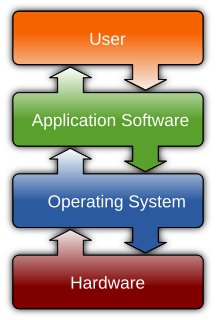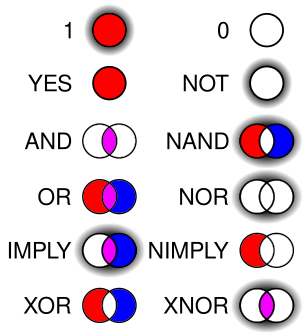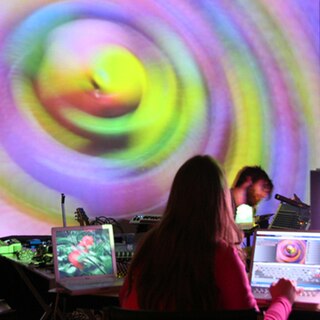
Computer software, or simply software, is a collection of data or computer instructions that tell the computer how to work. This is in contrast to physical hardware, from which the system is built and actually performs the work. In computer science and software engineering, computer software is all information processed by computer systems, programs and data. Computer software includes computer programs, libraries and related non-executable data, such as online documentation or digital media. Computer hardware and software require each other and neither can be realistically used on its own.
Computer music is the application of computing technology in music composition, to help human composers create new music or to have computers independently create music, such as with algorithmic composition programs. It includes the theory and application of new and existing computer software technologies and basic aspects of music, such as sound synthesis, digital signal processing, sound design, sonic diffusion, acoustics, and psychoacoustics. The field of computer music can trace its roots back to the origins of electronic music, and the very first experiments and innovations with electronic instruments at the turn of the 20th century.
Program, programme, or programming may refer to:

An embedded system is a controller programmed and controlled by a real-time operating system (RTOS) with a dedicated function within a larger mechanical or electrical system, often with real-time computing constraints. It is embedded as part of a complete device often including hardware and mechanical parts. Embedded systems control many devices in common use today. Ninety-eight percent of all microprocessors manufactured are used in embedded systems.
A music sequencer is a device or application software that can record, edit, or play back music, by handling note and performance information in several forms, typically CV/Gate, MIDI, or Open Sound Control (OSC), and possibly audio and automation data for DAWs and plug-ins.
In computing, a plug and play (PnP) device or computer bus, is one with a specification that facilitates the discovery of a hardware component in a system without the need for physical device configuration or user intervention in resolving resource conflicts. The term "plug and play" has since been expanded to a wide variety of applications to which the same lack of user setup applies.
A software synthesizer, also known as a softsynth, or software instrument is a computer program, or plug-in that generates digital audio, usually for music. Computer software that can create sounds or music is not new, but advances in processing speed now allow softsynths to accomplish the same tasks that previously required the dedicated hardware of a conventional synthesizer. Softsynths are usually cheaper and more portable than dedicated hardware, and easier to interface with other music software such as music sequencers.

An autopilot is a system used to control the trajectory of an aircraft without constant 'hands-on' control by a human operator being required. Autopilots do not replace human operators, but instead they assist them in controlling the aircraft. This allows them to focus on broader aspects of operations such as monitoring the trajectory, weather and systems.
Installation of a computer program, is the act of making the program ready for execution. Because the process varies for each program and each computer, programs often come with an installer, a specialized program responsible for doing whatever is needed for their installation. Installation may be part of a larger software deployment process.
In computer science, the term automatic programming identifies a type of computer programming in which some mechanism generates a computer program to allow human programmers to write the code at a higher abstraction level.

Logic in computer science covers the overlap between the field of logic and that of computer science. The topic can essentially be divided into three main areas:
Software deployment is all of the activities that make a software system available for use.
In music, transcription can mean notating a piece or a sound which was previously unnotated, as, for example, an improvised jazz solo. When a musician is tasked with creating sheet music from a recording and they write down the notes that make up the piece in music notation, it is said that they created a musical transcription of that recording. Transcription may also mean rewriting a piece of music, either solo or ensemble, for another instrument or other instruments than which it was originally intended. The Beethoven Symphonies by Franz Liszt are a good example. Transcription in this sense is sometimes called arrangement, although strictly speaking transcriptions are faithful adaptations, whereas arrangements change significant aspects of the original piece.
Systems management refers to enterprise-wide administration of distributed systems including computer systems. Systems management is strongly influenced by network management initiatives in telecommunications. The application performance management (APM) technologies are now a subset of Systems management. Maximum productivity can be achieved more efficiently through event correlation, system automation and predictive analysis which is now all part of APM.

VJing is a broad designation for realtime visual performance. Characteristics of VJing are the creation or manipulation of imagery in realtime through technological mediation and for an audience, in synchronization to music. VJing often takes place at events such as concerts, nightclubs, music festivals and sometimes in combination with other performative arts. This results in a live multimedia performance that can include music, actors and dancers. The term VJing became popular in its association with MTV's Video Jockey but its origins date back to the New York club scene of the 70s. In both situations VJing is the manipulation or selection of visuals, the same way DJing is a selection and manipulation of audio.
The Electronic Visualization Laboratory (EVL) is a cross-disciplinary research lab at the University of Illinois at Chicago. It brings together faculty and students from the Art and Computer Science departments of UIC. The primary areas of research are in computer graphics, high-performance computer networking, and technological art.
Reverse engineering, also called back engineering, is the process by which a man-made object is deconstructed to reveal its designs, architecture, or to extract knowledge from the object; similar to scientific research, the only difference being that scientific research is about a natural phenomenon.
Noah Wardrip-Fruin is a professor in the Computational Media department of the University of California, Santa Cruz, and is an advisor for the Expressive Intelligence Studio. He is an alumnus of the Literary Arts MFA program and Special Graduate Study PhD program at Brown University. In addition to his research in digital media, computer games, and software studies, he served for 10 years as a member of the Board of Directors of the Electronic Literature Organization.

In computer engineering, computer architecture is a set of rules and methods that describe the functionality, organization, and implementation of computer systems. Some definitions of architecture define it as describing the capabilities and programming model of a computer but not a particular implementation. In other definitions computer architecture involves instruction set architecture design, microarchitecture design, logic design, and implementation.
MusicEase is a proprietary WYSIWYG scorewriter created by Gary Rader and produced by MusicEase Software. It enables computers using Microsoft Windows and Mac OS X to produce musical notation and listen to them in MIDI.






